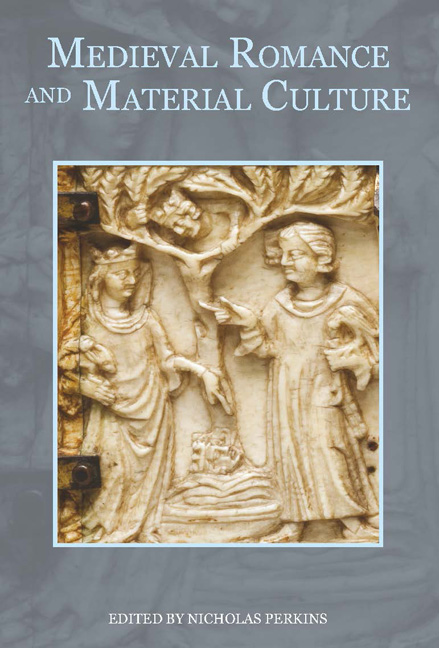Book contents
- Frontmatter
- Contents
- List of Illustrations
- List of Contributors
- Acknowledgements
- Abbreviations
- 1 Introduction: The Materiality of Medieval Romance and The Erle of Tolous
- 2 Courtly Culture and Emotional Intelligence in the Romance of Horn
- 3 Emplaced Reading, or Towards a Spatial Hermeneutic for Medieval Romance
- 4 Devotional Objects, Saracen Spaces and Miracles in Two Matter of France Romances
- 5 The Werewolf of Wicklow: Shapeshifting and Colonial Identity in the Lai de Melion
- 6 ‘Ladyes war at thare avowing’: The Female Gaze in Late-Medieval Scottish Romance
- 7 The Evolution of Cooperation in The Avowyng of Arthur
- 8 Ritual, Revenge and the Politics of Chess in Medieval Romance
- 9 Adventures in the Bob-and-Wheel Tradition: Narratives and Manuscripts
- 10 Reading King Robert of Sicily's Text(s) and Manuscript Context(s)
- 11 The Circulation of Romances from England in Late-Medieval Ireland
- 12 The Image of the Knightly Harper: Symbolism and Resonance
- 13 Carving the Folie Tristan: Ivory Caskets as Material Evidence of Textual History
- 14 Romancing the Orient: The Roman d'Alexandre and Marco Polo's Livre du grand Khan in Oxford, Bodleian Library MS Bodl. 264
- 15 The Victorian Afterlife of The Thornton Romances
- Index
1 - Introduction: The Materiality of Medieval Romance and The Erle of Tolous
Published online by Cambridge University Press: 05 May 2015
- Frontmatter
- Contents
- List of Illustrations
- List of Contributors
- Acknowledgements
- Abbreviations
- 1 Introduction: The Materiality of Medieval Romance and The Erle of Tolous
- 2 Courtly Culture and Emotional Intelligence in the Romance of Horn
- 3 Emplaced Reading, or Towards a Spatial Hermeneutic for Medieval Romance
- 4 Devotional Objects, Saracen Spaces and Miracles in Two Matter of France Romances
- 5 The Werewolf of Wicklow: Shapeshifting and Colonial Identity in the Lai de Melion
- 6 ‘Ladyes war at thare avowing’: The Female Gaze in Late-Medieval Scottish Romance
- 7 The Evolution of Cooperation in The Avowyng of Arthur
- 8 Ritual, Revenge and the Politics of Chess in Medieval Romance
- 9 Adventures in the Bob-and-Wheel Tradition: Narratives and Manuscripts
- 10 Reading King Robert of Sicily's Text(s) and Manuscript Context(s)
- 11 The Circulation of Romances from England in Late-Medieval Ireland
- 12 The Image of the Knightly Harper: Symbolism and Resonance
- 13 Carving the Folie Tristan: Ivory Caskets as Material Evidence of Textual History
- 14 Romancing the Orient: The Roman d'Alexandre and Marco Polo's Livre du grand Khan in Oxford, Bodleian Library MS Bodl. 264
- 15 The Victorian Afterlife of The Thornton Romances
- Index
Summary
The essays in this book explore how medieval romances respond to material culture, but also how romance itself helps to constitute and transmit that culture. In this introductory chapter I shall touch on how romances do this and why it might be important, but I should like to start with a very material example to provide a way of thinking about the theme of the collection.
Folio 2 recto of Oxford, Bodleian Library MS Ashmole 45 is the title page for a copy of the romance The Erle of Tolous (plate I). The title ‘The Story of the Erle of Tolous’ is written at the top of the page in display script, with an elaborate strapwork initial letter ‘T’, characteristic of legal and government scribes in London in the 1520s to 1530s. The page in fact mimics the developing layout of title pages in contemporary printed books. Beneath the title is a finely drawn pen-and-ink presentation picture, in which a young man appears to hand a book to a lady. His speech scroll contains the words ‘PRENES : ENGRE’. Under the couple, the words ‘Maid Maria’ are presented as a pair of monograms. In a valuable essay investigating this manuscript's context and ownership, Carol Meale has discussed the picture's artistic milieu and likely circumstances of production. She dates this copy of The Erle of Tolous to the late 1520s, linking the style of the presentation picture to the influence of a family of Flemish artists, the Horenbouts, who were active in London in the 1520s. The romance's scribe includes his name, ‘Morganus’, in the decorated initial of the opening of the text on fol. 3r, and Meale convincingly links his ‘variety of legal anglicana’ to analogous administrative and legal documents of the period. What is striking for our purposes is the way in which the likely gift of this book, perhaps on the occasion of the engagement or marriage of a well-to-do, urban couple, immediately binds the reading of the romance into a material environment.
- Type
- Chapter
- Information
- Medieval Romance and Material Culture , pp. 1 - 22Publisher: Boydell & BrewerPrint publication year: 2015



